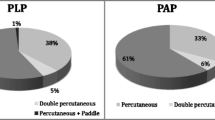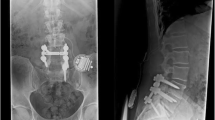Abstract
Background
De-novo chronic neuropathic pain following COVID-19 is widely recognised. However, there are currently no published studies investigating the effect of SARS-CoV-2 infection on patients with pre-existing neuropathic pain who have required spinal cord stimulator (SCS) implantation. Here, the authors aimed to analyse outcomes in their institution’s patients who had spinal cord stimulator (SCS) implantation or revision procedures to the system over a 5-year period. Specifically, the short-term and long-term outcomes of patients who contracted COVID-19 during the follow-up period were compared to the control group of patients who did not.
Method
Patients included in this study had spinal cord stimulator implantation (de-novo and revision procedures) between 1 January 2017 and 31 January 2022, for neuropathic pain of any aetiology. Patients deemed eligible for the study were invited to participate in a telephone survey through which clinical outcome data were collected. Pain scores were assessed with a modified form of the Brief Pain Inventory (BPI).
Results
Of 91 patients, 48 (52.7%) had contracted COVID-19 by the time of the survey. Patients who contracted COVID-19 had significantly worse BPI scores in the ‘Least pain’ domain following their infection and at time of the survey, when compared to their score 6 months after the operation. 22.9% (n = 11) of the patients who contracted COVID-19 experienced a change in their symptoms following their infection. Within this sub-group, there was a statistically significant deterioration in BPI scores in 10/11 domains following their infection and in 2/11 domains at time of the survey. Worsening severity of COVID-19 symptoms was not associated with worse BPI scores.
Conclusions
Infection with SARS-CoV-2, in a significant proportion of patients with an SCS in situ, causes at least a transient deterioration in pain control. Further prospective multicentre studies are indicated to establish the prevalence of this phenomenon.

Similar content being viewed by others
Data availability
Identifiable patient data has been strictly kept in password protected computers within the Nottingham University Hospitals NHS Trust.
Code availability
Not applicable.
References
Al-Kaisy A, Van Buyten JP, Smet I, Palmisani S, Pang D, Smith T (2014) Sustained effectiveness of 10 kHz high-frequency spinal cord stimulation for patients with chronic, low back pain: 24-month results of a prospective multicenter study. Pain Med (Malden, Mass.) 15(3):347–354
Bir SC, Konar S, Maiti T, Nanda A, Guthikonda B (2016) Neuromodulation in intractable pain management: outcomes and predictors of revisions of spinal cord stimulators. Neurosurg Focus 40(5):E4. https://doi.org/10.3171/2016.3.FOCUS15634
Cascella M, Rajnik M, Aleem A, et al (2023) Features, evaluation, and treatment of coronavirus (COVID-19). In: StatPearls [Internet]. Treasure Island (FL): StatPearls Publishing. Available from: https://www.ncbi.nlm.nih.gov/books/NBK554776/
Dawson EG, Kanim LE, Sra P, Dorey FJ, Goldstein TB, Delamarter RB, Sandhu HS (2002) Low back pain recollection versus concurrent accounts: outcomes analysis. Spine 27(9):984–994
Fayaz A, Croft P, Langford RM, Donaldson LJ, Jones GT (2016) Prevalence of chronic pain in the UK: a systematic review and meta-analysis of population studies. BMJ open 6(6):e010364. https://doi.org/10.1136/bmjopen-2015-010364
GBD 2016 Disease and Injury Incidence and Prevalence Collaborators (2017) Global, regional, and national incidence, prevalence, and years lived with disability for 328 diseases and injuries for 195 countries, 1990-2016: a systematic analysis for the Global Burden of Disease Study 2016. Lancet (London, England), 390(10100):1211–1259. https://doi.org/10.1016/S0140-6736(17)32154-2
Jordan RE, Adab P (2020) Who is most likely to be infected with SARS-CoV-2? Lancet Infect Dis 20(9):995–996
Joshi D, Gyanpuri V, Pathak A, Chaurasia RN, Mishra VN, Kumar A, Singh VK, Dhiman NR (2022) Neuropathic pain associated with COVID-19: a systematic review of case reports. Curr Pain Headache Reports 26(8):595–603. https://doi.org/10.1007/s11916-022-01065-3
Kemler MA, de Vet HC, Barendse GA, van den Wildenberg FA, van Kleef M (2008) Effect of spinal cord stimulation for chronic complex regional pain syndrome Type I: five-year final follow-up of patients in a randomized controlled trial. J Neurosurg 108(2):292–298
Kumaria A, Noah A, Kirkman MA (2022) Does covid-19 impair endogenous neurogenesis? J Clin Neurosci 105:79–85
Mao L, Jin H, Wang M, Hu Y, Chen S, He Q, Chang J, Hong C, Zhou Y, Wang D, Miao X, Li Y, Hu B (2020) Neurologic manifestations of hospitalized patients with coronavirus disease 2019 in Wuhan China. JAMA Neurol 77(6):683–690. https://doi.org/10.1001/jamaneurol.2020.1127
Matschke J, Lütgehetmann M, Hagel C, Sperhake JP, Schröder AS, Edler C, Mushumba H, Fitzek A, Allweiss L, Dandri M, Dottermusch M, Heinemann A, Pfefferle S, Schwabenland M, Sumner Magruder D, Bonn S, Prinz M, Gerloff C, Püschel K, Krasemann S, Aepfelbacher M, Glatzel M (2020) Neuropathology of patients with COVID-19 in Germany: a post-mortem case series. Lancet Neurol 19(11):919–929
Meyerowitz EA, Richterman A, Gandhi RT, Sax PE (2021) Transmission of SARS-CoV-2: a review of viral, host, and environmental factors. Ann Intern Med 174(1):69–79
Nissen M, Ikäheimo TM, Huttunen J, Leinonen V, von Und Zu, Fraunberg M (2019) Long-term outcome of spinal cord stimulation in failed back surgery syndrome: 20 years of experience with 224 consecutive patients. Neurosurg 84(5):1011–1018. https://doi.org/10.1093/neuros/nyy194
Oguz-Akarsu E, Gullu G, Kilic E, Dinç Y, Ursavas A, Yilmaz E, Zarifoglu M, Karli N, Pandemic Study Team (2022) Insight into pain syndromes in acute phase of mild-to-moderate COVID-19: frequency, clinical characteristics, and associated factors. Eur J Pain (London, England) 26(2):492–504. https://doi.org/10.1002/ejp.1876
Paniz-Mondolfi A, Bryce C, Grimes Z, Gordon RE, Reidy J, Lednicky J, Sordillo EM, Fowkes M (2020) Central nervous system involvement by severe acute respiratory syndrome coronavirus-2 (SARS-CoV-2). J Med Virol 92(7):699–702
Puelles VG, Lütgehetmann M, Lindenmeyer MT, Sperhake JP, Wong MN, Allweiss L, Chilla S, Heinemann A, Wanner N, Liu S, Braun F, Lu S, Pfefferle S, Schröder AS, Edler C, Gross O, Glatzel M, Wichmann D, Wiech T, Kluge S, Pueschel K, Aepfelbacher M, Huber TB (2020) Multiorgan and renal tropism of SARS-CoV-2. N Engl J Med 383(6):590–592
Sá KN, Moreira L, Baptista AF, Yeng LT, Teixeira MJ, Galhardoni R, de Andrade DC (2019) Prevalence of chronic pain in developing countries: systematic review and meta-analysis. Pain Reports 4(6):e779. https://doi.org/10.1097/PR9.0000000000000779
Shanthanna H, Nelson AM, Kissoon N, Narouze S (2022) The COVID-19 pandemic and its consequences for chronic pain: a narrative review. Anaesthesia 77(9):1039–1050. https://doi.org/10.1111/anae.15801
Soares FHC, Kubota GT, Fernandes AM, Hojo B, Couras C, Costa BV, Lapa JDDS, Braga LM, Almeida MM, Cunha PHMD, Pereira VHH, Morais ADS, Teixeira MJ, Ciampi de Andrade D, Pain in the Pandemic Initiative Collaborators (2021) Prevalence and characteristics of new-onset pain in COVID-19 survivours, a controlled study. Eur J Pain (London, England) 25(6):1342–1354. https://doi.org/10.1002/ejp.1755
Tan G, Jensen MP, Thornby JI, Shanti BF (2004) Validation of the Brief Pain Inventory for chronic nonmalignant pain. J Pain 5(2):133–137. https://doi.org/10.1016/j.jpain.2003.12.005
The University of Texas MD Anderson Cancer Center (2023) Brief pain inventory (Short Form). Retrieved from MD Anderson Cancer Centre: https://www.mdanderson.org/content/dam/mdanderson/documents/Departments-and-Divisions/Symptom-Research/BPI-SF_English-24h_Original_SAMPLE.pdf. Accessed 20 Dec 2023
Vallejo R, de Leon-Casasola O, Benyamin R (2004) Opioid therapy and immunosuppression: a review. Am J Ther 11(5):354–365
Funding
This study did not receive any dedicated funding.
Author information
Authors and Affiliations
Contributions
RK performed the literature review, AB performed the data collection and analysis and SB maintained overall supervision of the study and edited the paper prior to submission for publication. RK and AB contributed equally to this paper and should be considered its co-first authors.
Corresponding author
Ethics declarations
Ethics approval
Formal approval for this study was obtained from the Nottingham University Hospitals NHS Foundation Trust’s audit and research department.
Consent to participate
Verbal consent was received from all participants prior to participation in the telephone survey.
Consent for publication
All authors are in agreement for this manuscript to be submitted for publication.
Conflicts of interest/Competing interests
The authors have no conflicts of interest or competing interests to declare.
Additional information
Publisher's Note
Springer Nature remains neutral with regard to jurisdictional claims in published maps and institutional affiliations.
Previous presentations
This paper was presented at Society of British Neurological Surgeons Conference in London (13th-15th September 2023).
Supplementary Information
Below is the link to the electronic supplementary material.
Rights and permissions
Springer Nature or its licensor (e.g. a society or other partner) holds exclusive rights to this article under a publishing agreement with the author(s) or other rightsholder(s); author self-archiving of the accepted manuscript version of this article is solely governed by the terms of such publishing agreement and applicable law.
About this article
Cite this article
Kanjilal, R., Bagchi, A. & Basu, S. The effect of COVID-19 on pain control in patients with a neurostimulator in situ- a retrospective study. Acta Neurochir 166, 175 (2024). https://doi.org/10.1007/s00701-024-06014-0
Received:
Accepted:
Published:
DOI: https://doi.org/10.1007/s00701-024-06014-0




